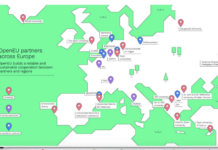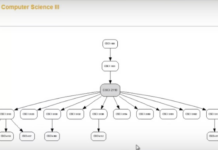
There are several scholarly texts on this topic. Paul Saettler’s ‘History of Instructional Technology‘ is a classic, but only goes up to 1968. A lot has happened since then. What you will get here is the postage stamp version.
However, my point in doing this is to show how education has adopted and adapted technology over a long period of time. There are some useful lessons to be learned from this, even though the term ‘paradigm shift’ is justifiable regarding the invention of the Internet and its impact on education.
Table 1 The development of technologies used in teaching up to 1990
————————————————————————————–
Development Year in general use
————————————————————————————–
Teachers 1500 BC (at least)
Printed book 1450
Postal service 1850
Blackboards (chalk) 1850
Telephone 1890
Radio 1920
Film 1920
Broadcast television 1950
Cable TV 1950
Audio-cassettes 1965
Computer-based instruction 1970
Satellite TV 1975
Laser video discs 1975
Audio-conferencing 1975
Personal computers 1980
Audio-graphics 1980
Viewdata/Teletext 1980
Computer conferencing (CMC) 1980
Compact discs (CDs) 1985
E-mail 1985
Video-conferencing 1990
Projectors 1990
Smart Board 1990
————————————————————————————–
Table 2 though shows the rapid expansion of new technologies introduced into education since 1990:
Table 2 The development of technologies used in teaching from 1990
————————————————————————————–
Development Year in general use
————————————————————————————–
Internet 1990
World Wide Web 1990
Simulations and games 1990
Learning management systems 1995
Browsers/web portals 1995
Wireless networks 1995
Mobile phones 1995
Learning objects/OERs 1995
Fibre optic cables 2000
DVDs 2000
Search engines 2000
Social software 2002
Virtual reality 2003
e-Portfolios 2005
Clickers 2005
YouTube 2005
Lecture capture 2008
e-books 2009
Cloud computing 2010
Learning analytics 2011
————————————————————————————–
Comments and questions
1. What have I missed that’s important for education?
2. You can argue about the dates. I’ve worked roughly on when these technologies have been generally available, although, in general, education takes 2-5 years to start using technologies widely that have become publicly popular.
3. Note that with the possible exception of the blackboard (the Smart Board is an electronic blackboard) and the LMS, none of these technologies was invented for educational use.
4. What constitutes an educational technology? Would you classify the tablets of stone that Moses used for the Ten Commandments in the Old Testament as an educational technology? Were St Paul’s epistles to the Corinthians an early form of distance education? How would you classify a recorded lecture from MIT that is accessed as an OER? How much does form and function rather than equipment influence the definition of an educational technology, especially since form and function can change within the same technology? When is a technology educational and not just a technology?
5. Teachers and print have been around for a very long time. It’s probably illogical to consider a person as a technology, but humans are definitely a means of communication and play (or have played) a key role in education. How to relate humans to technology in the educational process is an issue that I will come back to time and again in following posts on this subject.
6. I’ve made a division between pre- and post-Internet. I realise that a form of the Internet (Arpanet) existed long before 1990, but the combination of Internet protocols and the development of html and the World Wide Web are clearly a turning point in both telecommunications and education (at least for me). What then makes the Internet/the Web a paradigm shift? Or are they just an evolution, an orderly next step in educational technology?
7. Not much since 2005, mainly because it’s likely to take a few years to judge what’s relevant and what’s not. Only time will tell whether the last few will ‘stick.’
8. Is writing a technology? Is a lecture a technology? Does it matter to decide this?
9. The more sharp eyed or analytic of you may start to ask questions about the categorization or definition of some of the technologies listed above (quite apart from the issue of how to deal with people as means of communication). For instance computer-mediated communication (CMC) existed before the Internet (from 1978 in fact), but isn’t it an Internet technology? (It is now, but wasn’t then) How do social media differ from CMC? Does it make sense to distinguish television technologies such as broadcast, cable, satellite, DVDs or video-conferencing, and is this relevant any more? If so, what distinguishes them and what do they have in common from an educational perspective? These are some of the issues I will be getting into in subsequent posts.
Homework
You can see I’m better at asking questions than providing answers, but we are on first steps here. I’ll discuss all these questions in following posts. In the meantime, any initial thoughts from you on these questions or the post as a whole will be most welcome.
Further reading
Some clues to how I’m going to approach these questions can be found in: Technology, e-Learning and Distance Education, Routledge, 2005. But a lot will be different, too. A more extensive reading list will be developed as we progress.









 Dr. Tony Bates is the author of eleven books in the field of online learning and distance education. He has provided consulting services specializing in training in the planning and management of online learning and distance education, working with over 40 organizations in 25 countries. Tony is a Research Associate with Contact North | Contact Nord, Ontario’s Distance Education & Training Network.
Dr. Tony Bates is the author of eleven books in the field of online learning and distance education. He has provided consulting services specializing in training in the planning and management of online learning and distance education, working with over 40 organizations in 25 countries. Tony is a Research Associate with Contact North | Contact Nord, Ontario’s Distance Education & Training Network.


[…] Models for selecting and using technology: 2. A (very) short history of educational technology and w… […]
As loathe as I am to mention them, one that seems to be missed is “clickers.”
Nitpicking, but the web really dates from ’92 outside of an extremely tiny group of people. “Browsers/web portals” seems like not a useful category. “Virtual Reality” needs to be dated much earlier (I wrote part of my thesis on it in 1992.)
Generally, I think your pre/post internet distinction/date IS valid, but the dates post-internet (which I’m obviously more familiar with) all seem off by a few years, but that’s probably here nor there.
I very much look forward to the rest of the pieces in this series as this is a topic of great interest. Cheers, Scott
I look forward to the discussions on this topic.
Points of clarification:
I was one of approximately 3000 people at UBC who received an UNIX account and Pine email access but that was not until at least 1991.
Search engines for education. In 1994 I took a course at UBC titled “Using Mosaic as a research tool”. This the browser that became Netscape et al.
[…] The first two were Models for selecting and using technology: 1. the challenge, and Models for selecting and using technology: 2. A (very) brief history of educational technology. […]
[…] learning. The first three were Models for selecting and using technology: 1. the challenge, 2. Models for selecting and using technology: 2. A (very) brief history of educational technology and 3. Models for selecting and using technology: 3. Broadcast or […]
[…] and learning. The first four were Models for selecting and using technology: 1. the challenge, 2. Models for selecting and using technology: 2. A (very) brief history of educational technology, 3. Models for selecting and using technology: 3. Broadcast or communicative? and 4. Models for […]